Cody Webster
Well-Known Member
- Joined
- Mar 21, 2016
- Messages
- 221
- Reaction score
- 27
Hello all!
I have been looking at blue tube for use on some mpr's. Are they worth the money? And do you use the same building supplies as reguler paper tubes? Wood glue etc?
I have been looking at blue tube for use on some mpr's. Are they worth the money? And do you use the same building supplies as reguler paper tubes? Wood glue etc?





